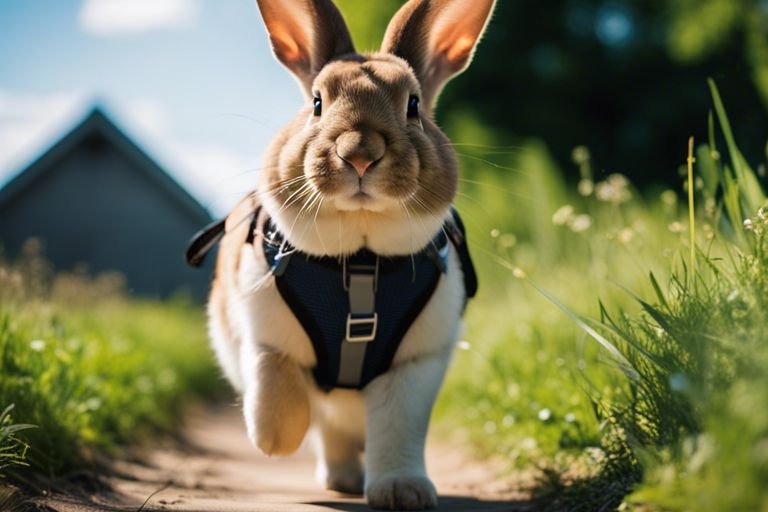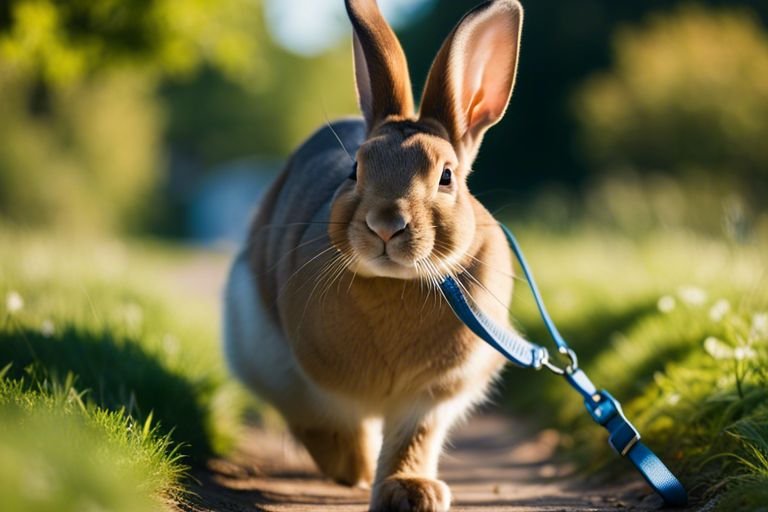Are you wondering if it is possible to train Flemish Giants to walk on a leash or harness? The idea of taking your giant rabbit for a stroll may seem far-fetched, but it is indeed possible with the right approach. Training your Flemish Giant to walk on a leash or harness can provide them with much-needed exercise and enrichment, but it also comes with potential risks that you need to be aware of. In this blog post, we will explore the process of training a Flemish Giant to walk on a leash or harness, as well as the benefits and potential dangers associated with this activity.
Key Takeaways:
- Flemish Giants can be trained to walk on a leash or harness. With patience and consistency, these large rabbits can learn to walk on a leash just like a dog.
- Start training at a young age. Introducing a Flemish Giant to a leash or harness as a young rabbit will make the training process much easier and more successful.
- Use positive reinforcement. Rewarding your Flemish Giant with treats and praise during the training process will help them associate the leash or harness with positive experiences.
- Be patient and persistent. It may take time for a Flemish Giant to become comfortable with wearing a leash or harness, so it’s important to be patient and consistent with training sessions.
- Always supervise your Flemish Giant while on a leash or harness. Like any animal, Flemish Giants can get easily distracted or frightened, so it’s crucial to always keep an eye on them while they are on a leash or harness.
Preparing for Leash Training
Clearly, you are interested in training your Flemish Giant to walk on a leash or harness. Before you begin the training process, it’s important to prepare yourself and your rabbit for the task at hand. To learn more about leash training and rabbits, check out this article on Can You Leash Train a Rabbit?
Assessing Temperament and Energy Levels
When it comes to leash training any animal, it’s important to consider their temperament and energy levels. Assessing your Flemish Giant’s temperament is crucial, as some rabbits may be more prone to fear, anxiety, or aggression. Likewise, you need to take into account your rabbit’s energy levels – some rabbits may be more energetic and willing to explore, while others may be more laid back and prone to laziness. Understanding your rabbit’s personality will help you tailor the training process to their specific needs.
Importance of Early Socialization
Early socialization is key when it comes to training your Flemish Giant to walk on a leash. Introducing your rabbit to new experiences, people, and environments from a young age can help build confidence and trust, which will make the training process smoother and more successful. By exposing your rabbit to a variety of stimuli early on, you can help them become more adaptable and less fearful of new experiences, including wearing a harness and walking on a leash.
Introducing the Harness
Before you can start leash training, introducing your rabbit to the harness is a crucial step. Start by allowing your rabbit to get used to the harness in a comfortable, safe environment. Let them sniff, explore, and even wear the harness for short periods of time indoors before attempting to attach the leash and venture outside. It’s important to make the introduction of the harness a positive experience for your rabbit, offering plenty of rewards and praise along the way.
By taking the time to assess your rabbit’s temperament, prioritize early socialization, and carefully introduce the harness, you can set the stage for successful leash training. Keep in mind that every rabbit is unique, and the training process may take time and patience. But with the right approach, you can enjoy the rewards of bonding with your Flemish Giant as you explore the great outdoors together.

Training Techniques for Flemish Giants
Now that you understand the importance of training your Flemish Giant to walk on a leash or harness, it’s time to delve into the specific techniques that will help you achieve success in this endeavor. It’s important to approach training with patience, consistency, and a positive attitude, as these qualities will go a long way in helping your rabbit feel comfortable and secure when walking on a leash or harness.
Positive Reinforcement and Clicker Training
Using positive reinforcement techniques, such as offering treats and praise, can be highly effective in teaching your Flemish Giant to walk on a leash or harness. Additionally, clicker training can be a valuable tool in reinforcing desired behaviors, as the sound of the clicker serves as an immediate marker for the rabbit to understand what it has done correctly.
Gradual Desensitization to Harness and Leash
One of the most important aspects of training your Flemish Giant to walk on a leash or harness is to gradually acclimate it to wearing these accessories. Start by introducing the harness and leash in a non-threatening environment, allowing your rabbit to explore and become familiar with them at its own pace. This will help reduce any fear or anxiety your rabbit may have towards the harness and leash.
Obedience Training Basics
Basic obedience training is essential for teaching your Flemish Giant to walk on a leash or harness. This includes teaching your rabbit to respond to simple commands, such as “come” or “stay,” which will be useful when walking on a leash. Consistency and patience are key when implementing obedience training, as it may take time for your rabbit to understand and respond to these commands.
As you delve into the training techniques for your Flemish Giant, it’s essential to remember that each rabbit is unique and may have different responses to training methods. Using a combination of positive reinforcement, gradual desensitization, and basic obedience training will help you effectively train your rabbit to walk on a leash or harness. Remember to remain patient and consistent throughout the training process, and celebrate each small success with enthusiasm to keep your rabbit motivated and engaged.
Health and Wellness Considerations
To ensure that your Flemish Giant stays healthy and happy, there are several important health and wellness considerations to keep in mind. From regular check-ups and vaccinations to parasite prevention and grooming, as well as proper nutrition and exercise, taking care of your bunny’s health is crucial.
Regular Check-ups and Vaccinations
Just like any other pet, regular check-ups and vaccinations are essential for your Flemish Giant’s overall health. You should schedule yearly appointments with a veterinarian who is experienced with rabbits. During these check-ups, your vet can assess your bunny’s overall health, provide necessary vaccinations, and address any concerns or potential health issues.
Parasite Prevention and Grooming
Parasites such as fleas, ticks, and mites can pose a threat to your Flemish Giant’s health. Make sure to regularly check your rabbit for any signs of parasites and consult with your vet on appropriate prevention methods. Additionally, grooming is important to keep your bunny’s fur clean and free from mats, which can lead to skin issues if neglected.
Nutrition and Exercise for Optimal Health
Proper nutrition and regular exercise are key components of maintaining your Flemish Giant’s optimal health. Ensure your bunny has a diet that is high in fiber, with plenty of fresh hay and leafy greens. You should also provide opportunities for exercise, such as time outside of the cage in a safe, rabbit-proofed area. Encouraging physical activity is crucial for preventing obesity and maintaining overall health.
Challenges and Solutions
However, training a Flemish Giant to walk on a leash or harness comes with its fair share of challenges. These gentle giants are known for their size and strength, which can make leash training a bit more difficult compared to smaller rabbit breeds. Additionally, their natural instincts and behavioral issues may also pose obstacles during training. Nevertheless, there are solutions and approaches that can help you successfully train your Flemish Giant to walk on a leash or harness.
Managing Size and Strength During Training
When it comes to managing the size and strength of a Flemish Giant during leash training, it is important to use a sturdy harness and leash that can comfortably restrain and control your rabbit. Additionally, **establishing firm and consistent** leadership during training will help communicate to your rabbit that you are in control and they should follow your lead. It’s also important to start small, gradually introducing them to the leash and harness in a safe and secure environment before moving on to more open spaces.
Addressing Behavioral Issues
Some Flemish Giants may exhibit behavioral issues such as stubbornness or fearfulness, which can make leash training challenging. **Consistent and patient** training, as well as positive reinforcement, can help address and correct these behavioral issues. It’s important to remain calm and assertive during training sessions, providing constant reassurance to your rabbit that the leash and harness are not threatening and that walking on them is a positive experience.
Alternative Training Approaches and Remedies
If traditional leash training methods are not yielding the desired results, there are alternative approaches and remedies that you can try. For example, using a **gentle leader head collar** as an alternative to a harness can provide better control over your rabbit’s movements during training. Moreover, seeking the guidance of a professional animal behaviorist can offer additional insights and **tailored solutions** for leash training your Flemish Giant.
Can Flemish Giants be trained to walk on a leash or harness?
With this in mind, it is important to understand that while Flemish Giants can be trained to walk on a leash or harness, it may take time, patience, and consistency. It is essential to start the training process early and to use positive reinforcement techniques. Additionally, it is crucial to ensure that the harness or leash used is properly fitted and comfortable for your rabbit. With dedication and the right approach, it is possible to train your Flemish Giant to walk on a harness or leash and enjoy the outdoors safely.
FAQ
Q: Can Flemish Giants be trained to walk on a leash or harness?
A: Yes, Flemish Giants can be trained to walk on a leash or harness. However, it will require patience, consistency, and positive reinforcement to successfully train them for this activity.
Q: What is the best age to start leash training a Flemish Giant?
A: The best age to start leash training a Flemish Giant is when they are still young, ideally around 12 weeks old. Starting the training process at a young age will help them become more accustomed to the leash and harness and more receptive to learning how to walk with it.
Q: What are some tips for leash training a Flemish Giant?
A: When leash training a Flemish Giant, start by getting them used to wearing the harness indoors before trying it outside. Use tasty treats as positive reinforcement and take short, gradual walks to build their confidence. Avoid forcing them to walk if they are reluctant, and always be patient and encouraging during the training process.
